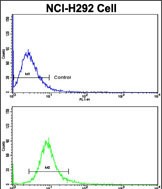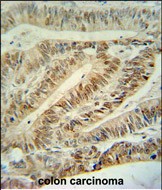CUL5 Antibody (C-term)
Purified Rabbit Polyclonal Antibody (Pab)
- 产品详情
- 实验流程
- 背景知识
Application
| WB, FC, IHC-P, E |
|---|---|
| Primary Accession | Q93034 |
| Other Accession | Q29425 |
| Reactivity | Human |
| Predicted | Rabbit |
| Host | Rabbit |
| Clonality | Polyclonal |
| Isotype | Rabbit IgG |
| Calculated MW | 90955 Da |
| Antigen Region | 747-774 aa |
| Gene ID | 8065 |
|---|---|
| Other Names | Cullin-5, CUL-5, Vasopressin-activated calcium-mobilizing receptor 1, VACM-1, CUL5, VACM1 |
| Target/Specificity | This CUL5 antibody is generated from rabbits immunized with a KLH conjugated synthetic peptide between 747-774 amino acids from the C-terminal region of human CUL5. |
| Dilution | WB~~1:1000 FC~~1:10~50 IHC-P~~1:100~500 E~~Use at an assay dependent concentration. |
| Format | Purified polyclonal antibody supplied in PBS with 0.09% (W/V) sodium azide. This antibody is prepared by Saturated Ammonium Sulfate (SAS) precipitation followed by dialysis against PBS. |
| Storage | Maintain refrigerated at 2-8°C for up to 2 weeks. For long term storage store at -20°C in small aliquots to prevent freeze-thaw cycles. |
| Precautions | CUL5 Antibody (C-term) is for research use only and not for use in diagnostic or therapeutic procedures. |
| Name | CUL5 {ECO:0000303|PubMed:10230407, ECO:0000312|HGNC:HGNC:2556} |
|---|---|
| Function | Core component of multiple cullin-5-RING E3 ubiquitin-protein ligase complexes (ECS complexes, also named CRL5 complexes), which mediate the ubiquitination and subsequent proteasomal degradation of target proteins (PubMed:11384984, PubMed:15601820, PubMed:21199876, PubMed:21980433, PubMed:23897481, PubMed:25505247, PubMed:27910872, PubMed:32200094, PubMed:33268465, PubMed:35512830, PubMed:38418882). Acts a scaffold protein that contributes to catalysis through positioning of the substrate and the ubiquitin-conjugating enzyme (PubMed:11384984, PubMed:15601820, PubMed:33268465). The functional specificity of the E3 ubiquitin-protein ligase complex depends on the variable SOCS box-containing substrate recognition component (PubMed:11384984, PubMed:15601820, PubMed:33268465). Acts as a key regulator of neuron positioning during cortex development: component of various SOCS-containing ECS complexes, such as the ECS(SOCS7) complex, that regulate reelin signaling by mediating ubiquitination and degradation of DAB1 (By similarity). ECS(SOCS1) seems to direct ubiquitination of JAK2 (PubMed:11384984). The ECS(SOCS2) complex mediates the ubiquitination and subsequent proteasomal degradation of phosphorylated EPOR and GHR (PubMed:21980433, PubMed:25505247). The ECS(SPSB3) complex catalyzes ubiquitination of nuclear CGAS (PubMed:38418882). ECS(KLHDC1) complex is part of the DesCEND (destruction via C-end degrons) pathway and mediates ubiquitination and degradation of truncated SELENOS selenoprotein produced by failed UGA/Sec decoding, which ends with a glycine (PubMed:32200094). The ECS(ASB9) complex mediates ubiquitination and degradation of CKB (PubMed:33268465). As part of some ECS complex, promotes 'Lys-11'- linked ubiquitination and degradation of BTRC (PubMed:27910872). As part of a multisubunit ECS complex, polyubiquitinates monoubiquitinated POLR2A (PubMed:19920177). As part of the ECS(RAB40C) complex, mediates ANKRD28 ubiquitination and degradation, thereby inhibiting protein phosphatase 6 (PP6) complex activity and focal adhesion assembly during cell migration (PubMed:35512830). As part of the ECS(RAB40A) complex, mediates RHOU 'Lys-48'-linked ubiquitination and degradation, thus inhibiting focal adhesion disassembly during cell migration (PubMed:26598620). As part of the ECS(RAB40B) complex, mediates LIMA1/EPLIN and RAP2 ubiquitination, thereby regulating actin cytoskeleton dynamics and stress fiber formation during cell migration (PubMed:33999101, PubMed:35293963). May form a cell surface vasopressin receptor (PubMed:9037604). |
| Cellular Location | Nucleus. Note=Localizes to sites of DNA damage in a UBAP2 and UBAP2L-dependent manner. |
For Research Use Only. Not For Use In Diagnostic Procedures.
Provided below are standard protocols that you may find useful for product applications.
BACKGROUND
CUL5 is a core component of multiple SCF-like ECS (Elongin-Cullin 2/5-SOCS-box protein) E3 ubiquitin-protein ligase complexes, which mediate the ubiquitination and subsequent proteasomal degradation of target proteins. As a scaffold protein may contribute to catalysis through positioning of the substrate and the ubiquitin-conjugating enzyme. The functional specificity of the E3 ubiquitin-protein ligase complex depends on the variable substrate recognition component. ECS(SOCS1) seems to direct ubiquitination of JAk2. It seems to be involved poteosomal degradation of p53/TP53 stimulated by adenovirus E1B-55 kDa protein and may form a cell surface vasopressin receptor.
REFERENCES
Kamura T., Burian D., Yan Q.J. Biol. Chem. 276:29748-29753(2001)
Mehle A., Goncalves J., Santa-Marta M.Genes Dev. 18:2861-2866(2004)
Kamura T., Maenaka K., Kotoshiba S.Genes Dev. 18:3055-3065(2004)
终于等到您。ABCEPTA(百远生物)抗体产品。
点击下方“我要评价 ”按钮提交您的反馈信息,您的反馈和评价是我们最宝贵的财富之一,
我们将在1-3个工作日内处理您的反馈信息。
如有疑问,联系:0512-88856768 tech-china@abcepta.com.























 癌症的基本特征包括细胞增殖、血管生成、迁移、凋亡逃避机制和细胞永生等。找到癌症发生过程中这些通路的关键标记物和对应的抗体用于检测至关重要。
癌症的基本特征包括细胞增殖、血管生成、迁移、凋亡逃避机制和细胞永生等。找到癌症发生过程中这些通路的关键标记物和对应的抗体用于检测至关重要。 为您推荐一个泛素化位点预测神器——泛素化分析工具,可以为您的蛋白的泛素化位点作出预测和评分。
为您推荐一个泛素化位点预测神器——泛素化分析工具,可以为您的蛋白的泛素化位点作出预测和评分。 细胞自噬受体图形绘图工具为你的蛋白的细胞受体结合位点作出预测和评分,识别结合到自噬通路中的蛋白是非常重要的,便于让我们理解自噬在正常生理、病理过程中的作用,如发育、细胞分化、神经退化性疾病、压力条件下、感染和癌症。
细胞自噬受体图形绘图工具为你的蛋白的细胞受体结合位点作出预测和评分,识别结合到自噬通路中的蛋白是非常重要的,便于让我们理解自噬在正常生理、病理过程中的作用,如发育、细胞分化、神经退化性疾病、压力条件下、感染和癌症。








